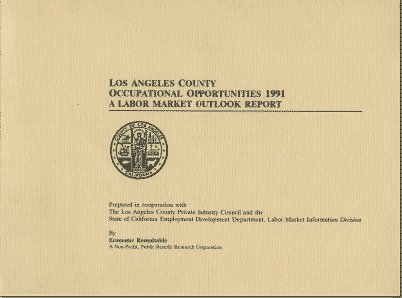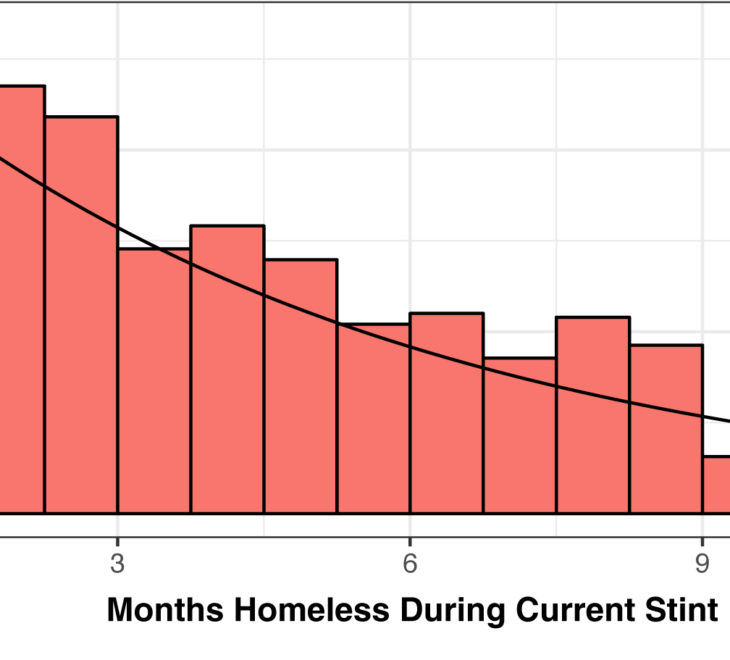SYNOPSIS
This is the second annual report of the Los Angeles State/Local Cooperative Information Project, an annual survey of selected occupations in the Los Angeles Area. The Economic Roundtable prepared this report for the Los Angeles County Private Industry Council, with the assistance of the California State Employment Development Department, Labor Market Information Division. Survey data were collected between December 1990 and May 1991. The goal of the project is to improve the match between employers’ labor needs and the skills of job seekers.
The following thirty-five occupations, as well as the industries that utilize them, are analyzed in this report:
- Adjustment Clerks
- Assemblers and Fabricators, Except Machine, Electrical, Electronic, and Precision
- Bill and Account Collectors
- Billing, Cost, and Rate Clerks
- Computer Operators, Except Peripheral Equipment
- Dental Assistants
- Electricians
- Food Preparation Workers
- Gardeners and Groundskeepers
- Insurance Policy Processing Clerks
- Janitors and Cleaners
- Legal Secretaries
- Licensed Vocational Nurses
- Machine Builders
- Machine Feeders and Offbearers
- Machinists
- Maids and Housekeeping Cleaners
- Numerical Control Machine Tool Operators
- Offset Lithographic Press Setters and Set-Up Operators
- Operating Engineers
- Order Clerks
- Photographic Processing Machine Operators
- Physical Therapy Aides
- Physical Therapy Assistants
- Procurement Clerks
- Production Inspectors, Testers, Graders, Sorters
- Production, Planning, and Expediting Clerks
- Sewing Machine Operators
- Small Engine Specialists
- Stock Clerks
- Teacher Aides
- Tellers
- Textile Machine Operators
- Tool and Die Makers
- Welders and Cutters
The following information is provided for each occupation
- OCCUPATIONAL DATA-five-year growth and job openings projections
- JOB MARKET-employer demand for experienced and inexperienced workers
- GROWTH- growth over the past year, three year projections, and national projections
- TRENDS-employer views on job opportunity, including specific factors influencing occupational demand
- WAGES-wages for three classes of employees in each occupation: entry (no experience), entry (with experience), and three years with firm
- SKILLS-description of skills, with ranking from not important to very important
- HIRING PRACTICES-employer preference for inexperienced versus experienced applicants EDUCATION AND TRAINING-the level of education most of recently hired employees
- EXPERIENCE-length of previous experience sought by employers
- MAJOR EMPLOYMENT SECTORS-the industrial composition of jobs in each occupation
- JOB LADDERS-promotional opportunities for the successful worker
- UNIONIZATION-information about employer used of union workers
- BENEFITS-benefits employers provide for employees CALIFORNIA OCCUPATIONAL GUIDES-availability of state occupational guides
Survey Findings About Labor Market Conditions
New Hires (Including Turnover)
Of new hires, 34% were for new positions resulting from growth, 8% were due to promotions within the firm, and 57% were due to people leaving the firm.
Education and Vocational Training
- 16% reported that most workers have less than high school
- 71% reported that most workers have high school or equivalent
- 10% reported that most workers have Associate’s Degree
- 3% reported that most workers have Bachelor’s Degree
- 19% reported less than 3 months vocational training for most workers
- 28% reported from 3 to 11 months vocational training for most workers
- 23% reported from 1 to 2 years vocational training for most workers
- 12% reported over 2 years
- 17% reported formal apprenticeship training
Experience
Seventy-one percent of the firms reported that related work experience is usually required of job applicants. About a fifth of the firms reported that it was very difficult to find either experienced or inexperienced applicants who met their hiring standards.
Length Of Tenure
Two-thirds of firms reported that they still had more than half of their new hires after three years.
Promotions Within Three Years
Percent of employees promoted within three years:
- More than 50% 15.7%
- 25 to 50% 17.7%
- 10 to 24% 26.4%
- Less than 10% 40.3%
Working Hours
Forty-seven percent of workers had regular, full-time jobs; 49 percent had regular, part-time jobs, typically working 20 hours a week; and 4% of workers were temporary, seasonal, or “on call.”
Prospects For Growth
Firms were asked to indicate what they expected would happen to employment in surveyed occupations over the next three years:
- Grow 34.5%
- Remain Stable 56.1%
- Decline 9.4%
Skill Requirements
Firms were asked to indicate what they expected would happen to skills in the surveyed occupations over the next five years:
- Remain the same 36.7%
- Change gradually 58.1%
- Change dramatically 5.2
Promotions By Industry
High promotion rates were noted for the following industries:
- Electrical Contractors
- Furniture
- Printing
- Industrial Machinery
- Department Stores
- Grocery Stores
- Banking
- Savings and Loans
- Insurance
- Business Services
- Repair Services
Future Skill Demands By Industry
In the following industries, a high proportion of firms expected job skills demands to change dramatically:
- Printing
- Plastic Products
- Fabricated Metal Products
- Industrial Machinery
- Aircraft and Parts
- Grocery Stores
- Insurance
- Business Services
- Repair Services
- Professional Services
Turnover By Industry
In the following industries a large share of firms reported high employee turnover:
- Heavy Construction
- Industrial Machinery
- Grocery Stores
- Automotive Dealers
- Eating and Drinking Places
- Insurance Carriers
- Personal Services
- Motion Pictures
- Health Services
Vocational Training By Industry
In the following industries, over half the firms said that most workers were trained for less than 3 months:
- Apparel
- Furniture
- Plastic Products
- Eating and Drinking Places
- Hotels
- Personal Services
Guide to Using Labor Market Information
The report includes a supplement that organizes information so that it can be used with greater ease and effectiveness by vocational students, counselors, teachers, and career seekers or job changers. The supplement contains questionnaires for matching the abilities and interests of applicants with jobs, detailed information about job families, and a chart indicating the steps which should be followed by the counselor or counselee to analyze, review, and help in selecting an area of work and making a career choice or occupation selection.
Chapter Headings:
- Overview of Major Industries
- Job Growth; Description of Occupations
- Occupational Summary Tables
- Analysis of Labor Market Conditions
- Counseling Guide to Using Labor Market Information













